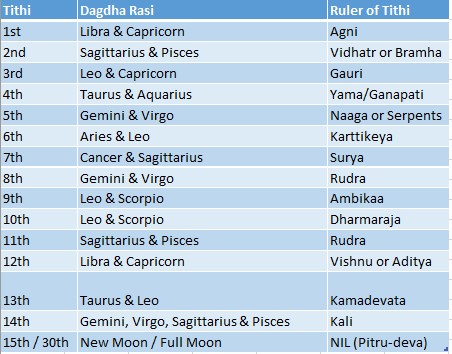Introduction to Dagdha Rashi
Vedic astrology is a profound science filled with intricate concepts, one of which is the often overlooked but potent “Dagdha Rashi.” The term “Dagdha” translates to “burnt” or “scorched,” and it signifies inauspiciousness. Understanding the impact of this is a crucial yet often ignored aspect of astrology. In this blog, we will explore its significance and its implications in astrological charts.
Unveiling the Tithi – Dagdha Rashi Connection
Tithi, the lunar day in the Vedic calendar, plays a critical role in determining the effects of Dagdha Rashi. Each Tithi corresponds to specific Rasis (zodiac signs), and these associations reveal the hidden dynamics of one’s life. The following table illustrates the connection between Tithis and Dagdha Rasis:

The Role of Tithi – Dagdha Rashi in Astrology
Despite its importance, the birth Tithi is often overshadowed by the emphasis placed on Nakshatras. However, understanding the connection between Tithi and this Rashi can unlock hidden secrets in astrological charts. Here’s a step-by-step breakdown of how to use this knowledge:
Step 1: Begin by determining the Tithi under which the native is born.
Step 2: Utilize the Tithi – Dagdha Rashi table to identify the relevant Dagdha Rashis associated with the Tithi.
Step 3: To determine which Dagdha Rashi has a more significant impact, subtract the degree of the Sun from the degree of the Moon. Then, divide the result by 12 and note the remainder. This will guide you in identifying the Karana.
Step 4: Examine the Karana in the context of the lunar phase – Krishna Paksha (dark fortnight) or Shukla Paksha (bright fortnight). Depending on the lunar phase, assign the Rasi order accordingly.
Step 5: After completing the above analysis, you’ll have identified two potential Rasi orders. To pinpoint the relevant Dagdha Rasi, consider which Rasi is closest to the Moon’s position in the birth chart.
Step 6: Pay close attention to the houses where Dagdha Rasis are situated. Keep in mind that their influence tends to be inauspicious, with a general tendency towards approximately 90% negative effects.
Step 7: Additionally, consider the effects carried by the lord of the Dagdha Rasi as it transits and resides in various houses of the birth chart. This step completes the assessment of the Dagdha Rasi’s impact and its implications for the native’s life journey.
Rules for Analyzing Effects
Understanding the rules governing the effects is essential in astrological analysis. Here are some key rules:
1. Loss of Power: Houses where Dagdha Rashi falls lose their strength, and their beneficial effects manifest only after significant efforts are made.
2. Effect on Rashi Lords: A similar principle applies to where the Dagdha Rasi lord is positioned.
3. Trikonas and Benefic Planets: Usually, Trikona houses and benefic planets yield positive results, but this is not the case when they come under its influence.
4. Malefic Houses and Retrograde Planets: If realated lords are located in the 3rd, 6th, 8th, or 12th houses from the ascendant, they may yield favorable results if accompanied by malefic planets or in retrograde positions.
5. Avoidance of Benefic Planets: Planets situated in THIS Rasi’s stars within the 3rd, 6th, 8th, and 12th houses do not typically produce favorable outcomes.
Conclusion
This concept adds depth to the analysis of astrological charts, providing insights into inauspicious and challenging influences. Astrologers and enthusiasts can use this knowledge to better understand the complexities of an individual’s life journey, guiding them towards informed decision-making and remedial measures to mitigate the adverse effects of Dagdha Rasi.
Click Here to access more such unique blogs.

Your astrology insights have brought clarity and guidance to my life. Thank you for your valuable contributions!
Thanks for your feedback
wow , great information
Thanks for your feedback